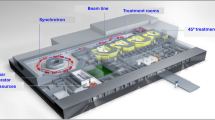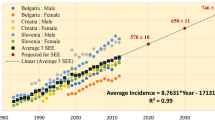Abstract
Purpose
MedAustron mission is to cure cancer by providing advanced patient care, clinical trials, applied and basic research, and know-how transfer. The facility is constantly striving to improve the therapy method of ion beam therapy, to increase its effectiveness and to make the treatment accessible to more people.
Methods
The MedAustron particle therapy accelerator facility is located in Austria and delivers protons in the energy range 60–250 MeV and carbon ions 120–400 MeV/n for tumor treatment to four irradiation rooms. Clinical treatment includes two rooms with fixed beam lines horizontal and horizontal/vertical and a third room with a rotating beam line, the proton gantry. A fourth irradiation room is dedicated to research delivering carbon and helium beams and where proton beams up to 800 MeV are also provided.
Results
The facility has been built, the commissioning has been completed and MedAustron is now successfully operating at its full functionality. Since the first patient treatment in December 2016, more than 2,000 patients have been treated at MedAustron.
Conclusions
In this paper, we provide an overview of the facility including the world-wide first so-called rotator system used, synchronously with the gantry, to improve the quality of the beam delivered at the patient. Furthermore, we discuss about the ongoing projects for improvement of the facility, the areas of research and potential topics for collaboration.












Similar content being viewed by others
Data availability
The data used to support the findings of this work are available from the corresponding author upon request.
Code availability
Not applicable
References
Badano L, Benedikt M, Bryant P, Crescenti M, Holý P, Maier A, Pullia M, Reimoser S, Rossi S. Proton-ion medical machine studies (PIMMS) parts I and II respectively CERN Technical Report Nos. CERN-PS-99-010-DI (1999) and CERN-PS-2000-007-DR (2000). https://cds.cern.ch/record/2858081?ln=en, https://cds.cern.ch/record/2858080?ln=en.
Amaldi U, Magrin G. The path to the italian national centre for ion therapy. Ed. Mercurio Cardo S.c.r.l; 2005. ISBN 978-88-95522-44-9.
Benedikt M, et al. Overview of the MedAustron design and technology choices. In: Proc. Int. Particle Accelerator Conf. Kyoto, Japan: (IPAC’10); 2010. p. 109–11.
Pedroni E, et al. The PSI Gantry 2: a second generation proton scanning gantry. Z Med Phys. 2004;14(1):25–34.
Benedikt M. Optics design of the extraction lines for the MedAustron hadron therapy centre. In: Nucl Instrum Methods Phys Res A, vol. 539. 2005. p. 25–36.
Schmitzer C, et al. Carbon Commissioning of the MedAustron Therapy Accelerator. In: Proc. 9th Int. Particle Accelerator Conf. Vancouver, BC, Canada: (IPAC’18); 2018. p. 457–9. https://doi.org/10.18429/JACoW-IPAC2018-MOPML027.
Kurfürst C, et al. Status of the MedAustron beam commissioning with protons and carbon ions. In: Proc. 9th Int. Particle Accelerator Conf. Vancouver, BC, Canada: (IPAC’18); 2018. p. 666–8. https://doi.org/10.18429/JACoW-IPAC2018-TUPAF004.
Indications treated at MedAustron, website: https://www.medaustron.at/en/indications/.
Kiseleva V, Gordon K, Vishnyakova P, Gantsova E, Elchaninov A, Fatkhudinov T. Particle therapy: clinical applications and biological effects. Life (Basel). 2022;12(12):2071. https://doi.org/10.3390/life12122071.
Hoppe BS, Petersen IA, Wilke BK, DeWees TA, Imai R, Hug EB, Fiore MR, Debus JN, Fossati P, Yamada S, Orlandi E, Zhang Q, Bao C, Seidensaal K, May BC, Harrell AC, Houdek MT, Vallow LA, Rose PS, Haddock MG, Ashman JB, Goulding KA, Attia S, Krishnan S, Mahajan A, Foote RL, Laack NN, Keole SR, Beltran CJ, Welch EM, Karim M, Ahmed SK. Pragmatic, prospective comparative effectiveness trial of carbon ion therapy, surgery, and proton therapy for the management of pelvic sarcomas (soft tissue/bone) involving the bone: the prosper study rationale and design. Cancers. 2023;15(6):1660. https://doi.org/10.3390/cancers15061660.
Acknowledgements
This article has been written on behalf of the MedAustron Technical Accelerator and the Medical Physics Divisions that we would like to Thank. We are thankful to Michael Benedikt and Ulrich Dorda for the optics design including the rotator and the original gantry optics and to Marco Pullia and Márius Pavlovič for the support with the beam commissioning.
Funding
The authors declare that no funds, grants, or other support were received during the preparation of this manuscript.
Author information
Authors and Affiliations
Contributions
All authors contributed to the study conception and design. Material preparation, data collection and analysis were performed by Mauro Pivi. The first draft of the manuscript was written by Mauro Pivi. All authors read and approved the final manuscript.
Corresponding author
Ethics declarations
Ethics approval
This study does not involve humans or animals.
Consent to participate
N.A.
Consent to publish
N.A.
Informed consent
An informed consent to publish has been obtained from all individual mentioned for whom identifying information is included in this article. In particular, informed consent was obtained from the individual Professors of whom names are cited in this article, to publish their identifying information. Informed consent was obtained from the MedAustron Institution to publish the data in the tables and figures of this article. In particular, informed consent has been obtained to publish the data in Fig. 11 of this article.
Conflict of interest
The author has no relevant financial or non-financial interests to disclose.
Additional information
Publisher's Note
Springer Nature remains neutral with regard to jurisdictional claims in published maps and institutional affiliations.
Rights and permissions
Springer Nature or its licensor (e.g. a society or other partner) holds exclusive rights to this article under a publishing agreement with the author(s) or other rightsholder(s); author self-archiving of the accepted manuscript version of this article is solely governed by the terms of such publishing agreement and applicable law.
About this article
Cite this article
Pivi, M.T.F. The MedAustron particle therapy accelerator facility. Health Technol. (2024). https://doi.org/10.1007/s12553-024-00840-z
Received:
Accepted:
Published:
DOI: https://doi.org/10.1007/s12553-024-00840-z




